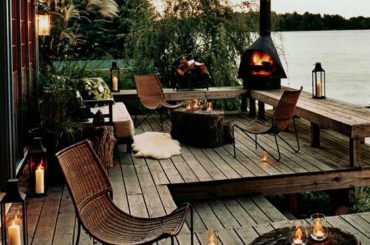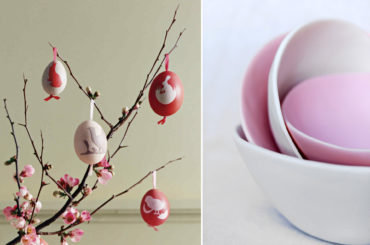
Jul22017by DishesOnly | News
A BBQ dinner is one of the reasons to love summer and to be hygge even in the heat. The Oxford Dictionary defines this trendy Danish lifestyle as “a quality of cosiness and comfortable conviviality that engenders a feeling of contentment or wellbeing.” You can be hygge any time as long as you set a cozy and relaxing mood and you enjoy the simple and good things in life. In Italy we adopted a slow-living approach, borrowing from the Slow Food movement 😉 So, hosting a BBQ dinner in your backyard, or on a terrace, or on a beach, and gathering your dearest friends, could be very “hoo-ga” (this is the correct pronunciation of hygge). Just follow these 5 simple rules. BBQ Dinner essentials 1. Light is the key Light is the most important factor to define an atmosphere and the character of a space, indoor as well as outdoor. Use string lights, candles, lanterns or tea lights. You can DIY hurricane candles holders or tea light centerpiece. 2. Fabrics matter To add charm and warmth to your space through around some pillows and throws (if it turns cold late at night) and use linen napkins on the table. Let them hang over from the place setting and choose a rustic pattern: best could be to use tea towels 3. Mise en place Choose your style, whether it is more rustic-chic (Materia or Latte dinner set) or rustic-classic (Quadrati or Mondrian dinner set). Pair the dinner set with wooden knifes and forks or with black metal cutlery – paying attention to a sharp knife if is a meat BBQ...

Jun112017by DishesOnly | News
Last week I hosted for dinner my niece and a couple of her friends. They are all in their twenties, the so called Millennials or Gen Y. We started talking about their lifestyle: what do they like, their favorites TV programs, the best singers, their hobbies. Apparently the three girls had contrasting preferences. They love science fiction and fantasy drama series such as Stranger Things, Sense8 or Games of Thrones . They are fans of Rihanna but also of a songwriter as Ed Sheeran (which, by the way, I like too). They cannot stay away from their smart phones and social networks, but they prefer to travel with their friends around the world. A must in their bedroom is a PC but, guess what, it could not be missing a picture board with printed photos… the old way… . Even fashion style is an oxymoron: shorts and sneakers with long shirts on top as in the 70’s, as well as jeggings (a mix of leggings and skinny jeans), better if ripped 😉 . The interesting thing for me is that these girls are able to manage direct opposites; they create harmony between old and new, combining together a sort of vintage charm and crazy patterns from the past, with simplicity and modern lines. They love nature, calmness and they pay attention to live the present and taking time to appreciate the moment. Design trends I was curious to ask them which were the DishesOnly collections they liked the most. The answer was coherent with the latest design trends: they adore the messy beauty of natural and organic shapes, as...

May172017by DishesOnly | News
Arrivano le prime vere giornate di primavera e con esse anche l’idea di uscire all’aperto, dopo le coperte e i rifugi invernali. Arriva con maggio, finalmente, l’idea di uscire, di mettere “muso e zampe” di fuori… è questo, insomma, il momento della gita fuoriporta! Noi di Dishes Only ci siamo guardati un attimo intorno, o meglio nei vicini o meno vicini dintorni della nostra amata Roma, e abbiamo cominciato a pensare dove sarebbe bello andare, prima col pensiero e poi anche di fatto! Ecco le mete che abbiamo scelto per voi, ma consideratele solo un piccolo assaggio, anzi, meglio, le consideriamo noi un piccolo assaggio, aspettando, di rimando, i vostri suggerimenti. Qual’è il vostro “fuoriporta”? Si accettano consigli… Noi, nel nostro continuo e amato gioco di suggestioni e di rimandi, abbiamo provato ad associare alcuni luoghi del cuore piatti del cuore, e questo è quello che uscito fuori dal cilindro… 😉 Bomarzo Bomarzo è un borgo del Lazio che si trova alle pendici del Monte Cimino, e che possiede un complesso monumentale nel suo genere unico al mondo: la Villa delle Meraviglie, o Sacro Bosco, spesso definito anche Parco dei Mostri, progettato dal principe Vicino Orsini e dall’architetto Pirro Ligorio nel 1552. I giardini all’italiana che vi si trovano sono realizzati su criteri di razionalità geometrica e prospettica, e fanno da contrappunto all’eccentrico “boschetto”, un labirinto ricco di figure di mostri, draghi, soggetti mitologici e animali esotici enigmatici e densi di simboli…Noi lo abbiamo associato all’alzata BORGIA Artistic Ceramic Cake Stand, che riesce a tenere benissimo insieme gli aggettivi misterioso ed elegante… Calcata Calcata è un piccolo comune italiano nella provincia di Viterbo, a 40 km a nord...

May42017by DishesOnly | News
How to cook the perfect pasta? If you really want to cook pasta as Italians do, here is what you need-to-know and the essential advice for cooking the perfect pasta. We take it for granted that the quality of the pasta should be excellent. We suggest Rummo , made with the best ingredients and in the traditional and artisan way. But, if you have time, and if you want to make your own fresh pasta, follow these steps on Sonia’s blog. Photo on the left: Oggi pane e salame, domani.... Photo on the right: Valdirose Once you have bought, or done, your spaghetti, fill up a large pan with cold water and bring it to boil. Drop in the pan, only after the water is boiling, a handful of salt. Weight the spaghetti as our Grandmothers use to do, by holding a bunch of spaghetti in your fist for each portion (as you see Italians use their hands to talk and also to cook !! ). Drop the spaghetti in the boiling water and turn them a couple of times with a wooden spoon or fork. Check the cooking time on the package . Now, pull up a chair and read our 5 secret tips to cook the perfect pasta. “Al dente” Cook the pasta always 2 minutes less then what it is written on the package. It will stay “al dente” and will allow you to mix in the condiment or sauce that you have prepared. “Risottata”: a chef touch! Get the sauce ready in a large flat pan. Add the spaghetti (or other pasta type) yet...

Apr112017by DishesOnly | News
Come decorare le uova con i colori naturali per il nostro centrotavola fatto in casa? Pasqua è davvero dietro l’angolo, e insieme alla primavera, al sole e ai colori, porta con sé voglia di piccole grandi novità, magari realizzate con le proprie mani e con quello che si ha a disposizione in casa. A volte basta una piccola accortezza per rendere la nostra tavola straordinaria: un ramo fiorito o decorato con dei nastri di raso, un cesto “rivestito” a mo’ di nido, un piatto speciale pieno di uova colorate in casa con colori e ingredienti naturali… Noi di Dishes ci siamo fatti un giro per la rete e abbiamo guardato nella nostra piattaia. Poi abbiamo messo insieme le due cose e in quattro e quattro otto sono uscite fuori delle idee per la tavola di pasqua che ci piacciono davvero tanto! Abbiamo scelto tre mood, tre dominanti di colore, e tre tra i nostri piatti preferiti: SABBIA Handmade Ceramic Bowl, per una tavola romantica e molto molto naturale, da basare sulle nuances corda e pastello. Per le uova i colori naturali che abbiamo scelto sono i toni caldi della rapa e della cipolla rossa, da accostare a uova “al naturale” o dal guscio bianco TRIBÙ Handmade Porcelain Bowls, color turchese, per una tavole energica e rilassante al tempo stesso. In questo caso si può giocare con il contrasto di colori, aggiungendo dei fiori gialli, rosa o chiari, e/o colorare le uova in tutti i toni freddi del celeste, blu e turchese, utilizzando il cavolo viola oppure il mirtillo, o la mora, o il gelso “nero”. JELLI BELLI Piece Handmade Resin Serving Set, nel colore giallo,...

Apr22017by DishesOnly | News, Recipes
There are two traditional Easter cake which cannot be missed on any Italian Easter dining table: Colomba and Pastiera. Colomba has a dove shape topped with pearl sugar and almonds. This very popular easter cake was invented in Lombardy, probably in Milan, in the north of Italy. Pastiera is a Neapolitan tart, from the South of Italy. The two ingredients that make it unique are the cooked wheat and the extract of orange flowers. The orange flower water flavor is a celebration of the just started spring season. According to a popular ancient legend, during the night the fishermen’s wives left on the beach some baskets filled with ricotta cheese, candied fruit, wheat, eggs and orange flowers as offerings for the “Sea”, to bring back safely their husbands to their houses. In the morning, when the wives went back to meet their husbands, they noticed that during the night the waves had mixed the ingredients together and that in the baskets of their returning husbands there was a cake: the Pastiera. Besides this legend, it is said that it was a nun that invented the modern Pastiera in the XVI century, in an ancient Neapolitan convent: San Gregorio Armeno. She wanted to bake a cake that had the same perfume of the orange flowers, which grew in the convent’s garden. Another story refers that Maria Theresa of Austria, King Ferdinand II of Bourbon’s wife, accepted to taste a slice of Pastiera smiling for the first time in public after she eat it. Having seen her smiling, Ferdinand said: “ To make my wife smile again I will...






